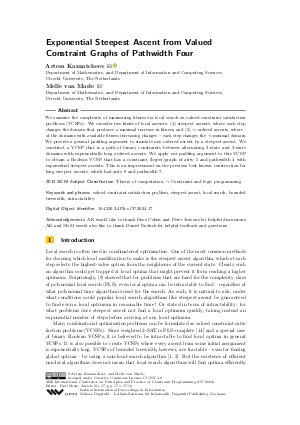Exponential Steepest Ascent from Valued Constraint Graphs of Pathwidth Four
Authors
Artem Kaznatcheev  ,
Melle van Marle
,
Melle van Marle
-
Part of:
Volume:
30th International Conference on Principles and Practice of Constraint Programming (CP 2024)
Part of: Series: Leibniz International Proceedings in Informatics (LIPIcs)
Part of: Conference: International Conference on Principles and Practice of Constraint Programming (CP) - License:
 Creative Commons Attribution 4.0 International license
Creative Commons Attribution 4.0 International license
- Publication Date: 2024-08-29
File

PDF
LIPIcs.CP.2024.17.pdf
- Filesize: 0.69 MB
- 16 pages
Document Identifiers
Subject Classification
ACM Subject Classification
- Theory of computation → Constraint and logic programming
Keywords
- valued constraint satisfaction problem
- steepest ascent
- local search
- bounded treewidth
- intractability
Metrics
- Access Statistics
-
Total Accesses (updated on a weekly basis)
0PDF Downloads0Metadata Views
Abstract
We examine the complexity of maximising fitness via local search on valued constraint satisfaction problems (VCSPs). We consider two kinds of local ascents: (1) steepest ascents, where each step changes the domain that produces a maximal increase in fitness; and (2) ≺-ordered ascents, where - of the domains with available fitness increasing changes - each step changes the ≺-minimal domain. We provide a general padding argument to simulate any ordered ascent by a steepest ascent. We construct a VCSP that is a path of binary constraints between alternating 2-state and 3-state domains with exponentially long ordered ascents. We apply our padding argument to this VCSP to obtain a Boolean VCSP that has a constraint (hyper)graph of arity 5 and pathwidth 4 with exponential steepest ascents. This is an improvement on the previous best known construction for long steepest ascents, which had arity 8 and pathwidth 7.
Cite As Get BibTex
Artem Kaznatcheev and Melle van Marle. Exponential Steepest Ascent from Valued Constraint Graphs of Pathwidth Four. In 30th International Conference on Principles and Practice of Constraint Programming (CP 2024). Leibniz International Proceedings in Informatics (LIPIcs), Volume 307, pp. 17:1-17:16, Schloss Dagstuhl – Leibniz-Zentrum für Informatik (2024)
https://doi.org/10.4230/LIPIcs.CP.2024.17
BibTex
@InProceedings{kaznatcheev_et_al:LIPIcs.CP.2024.17,
author = {Kaznatcheev, Artem and van Marle, Melle},
title = {{Exponential Steepest Ascent from Valued Constraint Graphs of Pathwidth Four}},
booktitle = {30th International Conference on Principles and Practice of Constraint Programming (CP 2024)},
pages = {17:1--17:16},
series = {Leibniz International Proceedings in Informatics (LIPIcs)},
ISBN = {978-3-95977-336-2},
ISSN = {1868-8969},
year = {2024},
volume = {307},
editor = {Shaw, Paul},
publisher = {Schloss Dagstuhl -- Leibniz-Zentrum f{\"u}r Informatik},
address = {Dagstuhl, Germany},
URL = {https://drops.dagstuhl.de/entities/document/10.4230/LIPIcs.CP.2024.17},
URN = {urn:nbn:de:0030-drops-207021},
doi = {10.4230/LIPIcs.CP.2024.17},
annote = {Keywords: valued constraint satisfaction problem, steepest ascent, local search, bounded treewidth, intractability}
}
Author Details
- Department of Mathematics, and Department of Information and Computing Sciences, Utrecht University, The Netherlands
Acknowledgements
AK would like to thank Dave Cohen and Peter Jeavons for helpful discussions. AK and MvM would also like to thank Daniel Dadush for helpful feedback and questions.
References
- Umberto Bertelè and Francesco Brioschi. On non-serial dynamic programming. Journal of Combinatorial Theory, Series A, 14(2):137-148, 1973. URL: https://doi.org/10.1016/0097-3165(73)90016-2.
- Clément Carbonnel, Miguel Romero, and Stanislav Živný. The complexity of general-valued constraint satisfaction problems seen from the other side. SIAM Journal on Computing, 51(1):19-69, 2022. URL: https://doi.org/10.1137/19M1250121.
-
David A Cohen, Martin C Cooper, Artem Kaznatcheev, and Mark Wallace. Steepest ascent can be exponential in bounded treewidth problems. Operations Research Letters, 48:217-224, 2020.

-
K. Crona, D. Greene, and M. Barlow. The peaks and geometry of fitness landscapes. Journal of Theoretical Biology, 317:1-10, 2013.

-
Reinhard Diestel. Graph Theory. Springer Publishing Company, Incorporated, 5th edition, 2017.

-
John H Gillespie. A simple stochastic gene substitution model. Theoretical population biology, 23(2):202-215, 1983.

-
Georg Gottlob, Gianluigi Greco, and Francesco Scarcello. Tractable optimization problems through hypergraph-based structural restrictions. In International Colloquium on Automata, Languages, and Programming, pages 16-30. Springer, 2009.

-
P. Jeavons, A. Krokhin, and S. Živný. The complexity of valued constraint satisfaction. Bulletin of the European Association for Theoretical Computer Science, 113:21-55, 2014.

- David S. Johnson, Christos H. Papadimitriou, and Mihalis Yannakakis. How easy is local search? Journal of Computer and System Sciences, 37(1):79-100, 1988. URL: https://doi.org/10.1016/0022-0000(88)90046-3.
-
Artem Kaznatcheev. Computational complexity as an ultimate constraint on evolution. Genetics, 212(1):245-265, 2019.

-
Artem Kaznatcheev. Algorithmic Biology of Evolution and Ecology. PhD thesis, University of Oxford, 2020.

-
Artem Kaznatcheev. Local search for valued constraint satisfaction parameterized by treedepth. ArXiv, 2024.

-
Artem Kaznatcheev, David A Cohen, and Peter Jeavons. Representing fitness landscapes by valued constraints to understand the complexity of local search. Journal of Artificial Intelligence Research, 69:1077-1102, 2020.

- Mark W. Krentel. On finding and verifying locally optimal solutions. SIAM Journal on Computing, 19(4):742-749, 1990. URL: https://doi.org/10.1137/0219052.
-
Daniel A Levinthal. Adaptation on rugged landscapes. Management Science, 43(7):934-950, 1997.

-
H. Allen Orr. The genetic theory of adaptation: a brief history. Nature Reviews. Genetics, 6:119-127, 2005.

-
Jan W Rivkin and Nicolaj Siggelkow. Patterned interactions in complex systems: Implications for exploration. Management Science, 53(7):1068-1085, 2007.

-
T Roughgarden. Computing equilibria: A computational complexity perspective. Economic Theory, 42:193-236, 2010.

-
Alexandru Strimbu. Simulating evolution on fitness landscapes represented by valued constraint satisfaction problems. arXiv:1912.02134, 2019.

-
S. Wright. The roles of mutation, inbreeding, crossbreeding, and selection in evolution. In Proc. of the 6th International Congress on Genetics, pages 355-366, 1932.

